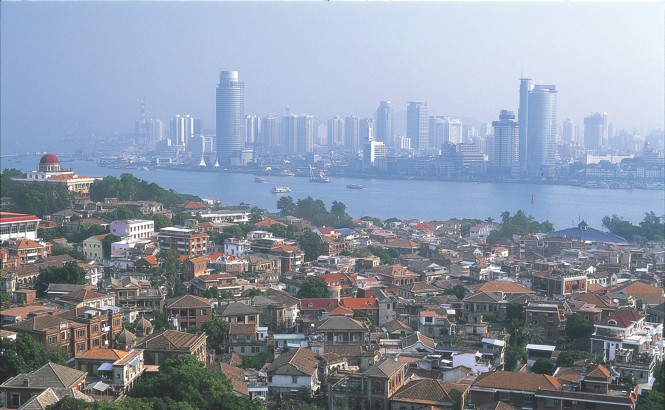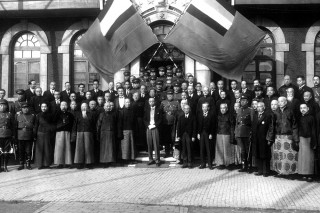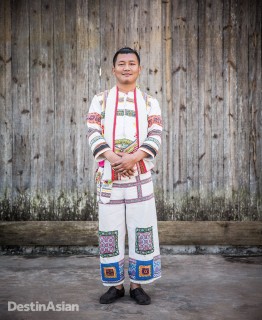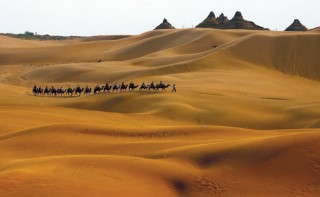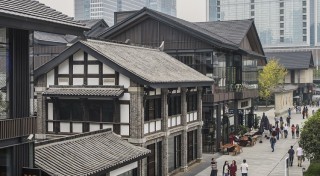Situated off the Fujian coast in southeast China, tiny Gulangyu, once dubbed an “Asian Riviera,” provides a traffic-free slice of colonial history
By Biju Sukumaran
You won’t find any cars on tiny Gulangyu, but you will find pianos—more than 200, as best as I can tell. They are reminders of the days when this two-square-kilometer islet served as an enclave for European merchants, missionaries, and envoys, who began establishing communities here in 1843 after the neighboring island of Xiamen—then known as Amoy —was pried open as one of China’s first treaty ports. The music-loving colonials, posted far from London, Amsterdam, Lisbon, or Berlin, shaped Gulangyu in the image of their homelands, filling it not just with pianos, but with a hodgepodge of Italianate villas, Victorian and Neoclassical mansions, and churches in any number of styles.
While Xiamen proper has evolved into a sprawling Special Economic Zone, time seems to have stood still on leafy, traffic-free Gulangyu, a five-minute ferry ride across the channel. Remarkably, much of the old architecture survived both the traumas of the Japanese occupation during World War II and the worst excesses of the Cultural Revolution. Now home to some 20,000 people, Gulangyu (the name means “Isle of the Drumming Waves”) has a museum-like quality to it—not to mention China’s only museum dedicated to the piano—making it a popular destination for day-tripping tourists from Xiamen and the mainland.
I join a ferry-load of them one morning, contemplating Gulangyu’s pink-tiled roofs as we move across the water. Toward the southeastern tip of the island, I can also see the towering granite statue of Zheng Chenggong —a.k.a. Koxinga—which speaks of an even earlier period of history. A controversial figure—at times worshipped as a hero, at times reviled as a pirate—Zheng Chenggong was a Ming dynasty general who based himself on Gulangyu after leading an armada against the Dutch in nearby Taiwan, and spent the rest of his life campaigning against the encroaching Manchus.
Disembarking at the ferry landing, I follow the crowds of predominantly Chinese tourists, whose flag-waving guides shepherd them with cries of “Lai le, lai le!”—”Come here, come here!”—amplified by handheld microphones. The main causeway feels like a theme park, with shrieking children running wild while their parents rest their legs on seaside benches, and stands selling Fujian specialties like jellied sea worm and grilled conch. The signs at street junctions point to attractions in Chinese and English, while workers quietly remove any and all trash from the area. Completing the picture is a sidewalk embossed with musical notes, laid down a decade or so ago by tourism boosters eager to play off Gulangyu’s reputation as “Piano Island.”
The chaos fades as I make my way inland. Stone archways and colonnaded facade loom on either side of the winding lanes; behind wrought-iron fences I glimpse manicured gardens ablaze with spring blooms. Beyond the shade of a banyan tree draped in Spanish moss, a group of giggling young tourists draws me to what looks like a small toy store. Ducking in from the street, I instead find myself in a café lined with ranks of toy-soldier nutcrackers, some life-size, some as small as my finger. The owner, who introduces himself as Jason, hails from Qinghai province, far to the northwest. As he whips up lattes and cappuccinos amid the blankly staring wooden figures, I ask him, why here, and why nutcrackers?
“Gulangyu is clean, I love it here,” he says, adding that he also loves coffee, especially the dark blends that he imports from Europe. “But most Chinese prefer tea to coffee, and probably wouldn’t stop here if it wasn’t for the nutcrackers.” With a wave to the giggling tourists taking snapshots with nutcrackers, he adds, “We should probably charge for taking photos with them, though.”
Back on the street, people are making way for a man hauling containers of water on a wooden cart. Gulangyu doesn’t even allow bicycles, and the sole exceptions to the no-vehicle rule are a few fire trucks and a handful of electric tourist buggies.
Following the piano music playing from outdoor speakers installed around the island, I walk on toward the south coast, and find myself in front of Shuzhuang Garden. Inside is one of Gulangyu’s most ballyhooed attractions, the Piano Museum. Here, a series of buildings houses more than 100 pianos from Germany, Austria, and England, all from the private collection of Hu Youyi, a Gulangyu native who went on to study music at the Royal Conservatory of Brussels before eventually settling in Australia.
Since the 1920s Gulangyu has produced several famous musicians, among them Shou Shu’an, who became China’s first choral director, and Chen Zuohuang, China’s first doctorate of musical arts. Today the Xiamen Music School, founded in 1988 and located on the island, boasts internationally acclaimed students and continues the long tradition of piano instruction. Hence the Piano Museum, whose exhibits include some strange and notable instruments, from a French street musician’s barrel piano to a magnificent grand crafted in 1801 by the composer Muzio Clementi. (For aficionados of this sort of thing, Gulangyu also has an Organ Museum—reportedly the world’s largest.)
The rest of my day is spent roaming between gardens and beaches. On the streets, musicians, fortunetellers, and artists ply their trade, strumming guitars, painting caricatures, and sculpting clay likenesses for eager customers. I stop to admire the Catholic church, a whitewashed Gothic structure that is silent today. Farther on, I stroll through the Gulangyu Aviary, where birds sing in counterpoint to the piano music as stately peacocks strut under the high, netted roof.
It is late in the afternoon before I stumble across an empty garden. On the grounds of the Fuzhou Art School, it’s filled with replicas of Hellenic and Renaissance statues. Eerie in the silence, the white faux-marble likenesses of Venus de Milo and David seem like displaced ghosts of another era, another civilization. Then the distant whistle of a ferry breaks the spell, and I realize it is time to go.
THE DETAILS:
GULANGYU
Getting There
Xiamen, the second-largest city in Fujian, is also the province’s main gateway for tourists. Cathay Pacific (cathaypacific.com) flies there several times a day from Hong Kong, while Silk Air (silkair.com) operates a regular service from Singapore. Boats depart the Gulangyu Ferry Terminal every 15 minutes.
Where to Stay
** Le Méridien Xiamen: The best choice for day-trippers from Xiamen proper. No. 7 Guanjun Lu, Nanshan, Xiamen; 86-592/770-9999; starwoodhotels.com; doubles from US$110.
** Miryam Boutique Hotel: A pleasant option for those wishing to spend a night or more on Gulangyu, with 15 colonial-style rooms situated at the foot of the isle’s highest peak. 70 Huangyan Lu; 86-592/206-2505; miryamhotel.com; doubles from US$106.
Originally appeared in the June/July 2011 print issue of DestinAsian magazine (“An Isle Apart”)

